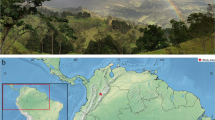Abstract
Many parasitoids control the behavior of their hosts to achieve more preferable conditions. Decreasing predation pressure is a main aim of host manipulation. Some parasitoids control host behavior to escape from their enemies, whereas others manipulate hosts into constructing defensive structures as barriers against hyperparasitism. Larvae of the parasitoid wasp Cotesia glomerata form cocoon clusters after egression from the parasitized host caterpillar of the butterfly Pieris brassicae. After the egression of parasitoids, the perforated host caterpillar lives for a short period and constructs a silk web that covers the cocoon cluster. We examined whether these silk webs protect C. glomerata cocoons against the hyperparasitoid wasp Trichomalopsis apanteroctena. In cocoon clusters that were not covered by silk webs (“bare” clusters), only cocoons hidden beneath others avoided hyperparasitism. In covered cocoon clusters, both cocoons hidden beneath others and those with a space between them and the silk web avoided hyperparasitism, whereas cocoons that contacted the silk webs were parasitized. The frequency of cocoons that were hidden beneath others increased with the increasing number of cocoons in a cluster, but the defensive effect of cluster size was thought to be lower than that of silk webs. However, the rate of hyperparasitism did not differ between covered and bare clusters when we allowed the hyperparasitoids to attack the cocoon clusters in an experimental arena. This result was thought to have been caused by low oviposition frequency by these hyperparasitoids. As a result, silk webs did not guard the cocoons from hyperparasitoids in our experiments, but would protect cocoons under high hyperparasitism pressure by forming a space through which the ovipositors could not reach the cocoons.








Similar content being viewed by others
References
Brodeur J, McNeil JN (1989) Seasonal microhabitat selection by an endoparasitoid through adaptative modification of host behavior. Science 244:226–228
Brodeur J, McNeil JN (1992) Host behaviour modification by the endoparasitoid Aphidius nigripes: a strategy to reduce hyperparasitism. Ecol Entomol 17:97–144
Brodeur J, Vet LEM (1994) Usurpation of host behaviour by a parasitic wasp. Anim Behav 48:187–192
Curio E (1976) The ethology of predation. Springer, Berlin Heidelberg New York
Eberhard WG (1975) The ecology and behavior of a subsocial pentatomid bug and two scelionid wasps: strategy and counterstrategy in a host and its parasites. Smithson Contrib Zool 205:1–39
Edmunds M (1974) Defence in animals. A survey of anti-predator defences. Longman, New York
Endler JA (1986) Natural selection in the wild. Princeton University Press, Princeton, N.J.
Fritz RS (1982) Selection for host medification by insect parasitoids. Evolution 36:283–288
Godfray HCJ (1994) Parasitoids. Behavioral and evolutionary ecology. Princeton University Press, Princeton, N.J.s
Gu H, Wang Q, Dorn S (2003) Superparasitism in Cotesia glomerata: response of hosts and consequences for parasitoids. Ecol Entomol 28:422–431
Harvey JA (2000) Dynamic effect of parasitism by an endoparasitoid wasp on the development of two host species: implications for host quality and parasitoid fitness. Ecol Entomol 25:267–278
Ikawa T, Okabe H (1985) Regulation of egg number per host to maximize the reproductive success in the gregarious parasitoid, Apanteles glomeratus L. (Hymenoptera: Braconidae). Appl Entomol Zool 20:331–339
Kamijo K, Grissell EE (1982) Species of Trichomalopsis Crawford (Hymenoptera, Pteromalidae) from rice paddy, with descriptions of two new species. Kontyu 50:76–87
Krause J, Ruxton GD (2002) Living in groups. Oxford University Press, Oxford
Lees DR (1981) Industrial melanism: genetic adaptation of animals to air pollution. In: Bishop JA, Cook LM (eds) Genetic consequences of man made change. Academic Press, London, pp 129–176
le Masurier AD (1991) Effect of host size on clutch size in Cotesia glomerata. J Anim Ecol 60:107–118
Matsuzawa H (1958) Ecological studies on the Braconid wasp, Apanteles glomeratus. Mem Fac Agric Kagawa Univ 3:1–125
Moore J (2002) Parasites and the behavior of animals. Oxford University Press, Oxford
Ohsaki N, Sato Y (1994) Food plant choice of Pieris butterflies as a trade-off between parasitoid avoidance and quality of plants. Ecology 75:59–68
Reznick DA, Endler JA (1982) The impact of predation on life history evolution in trinidadian guppies (Poecilia reticulata). Evolution 36:160–177
Reznick DA, Bryga H, Endler JA (1990) Experimentally induced life-history evolution in a natural population. Nature 346:357–359
Sato Y, Ohsaki N (1987) Host-habitat location by Apanteles glomeratus and effect of food-plant exposure on host-parasitism. Ecol Entomol 12:291–297
Sato Y, Ohsaki N (2004) Response of the wasp (Cotesia glomerata) to larvae of the large white butterfly (Pieris brassicae). Ecol Res 19:445–449
Sokal RR, Rohlf FJ (1995) Biometry. Freeman, New York
Tagawa J, Fukushima H (1993) Effects of host age and cocoon position on attack rate by the hyperparasitoid, Eurytoma sp. (Hym.: Eurytomidae), on cocoons of the parasitoid, Cotesia (=Apanteles) glomerata (Hym.: Braconidae). Entomophaga 38:69–77
Ueno M (2001) A note on Pieris brassicae. V. Invaded the whole are of Hokkaido. Yadoriga 189:1419
Woolley JB, Vet LEM (1981) Postovipositional web-spinning behavior in a hyperparasite, Signiphora coquillettl Ashmead (Hymenoptera: Signiphoridae). Neth J Zool 31:627–633
Acknowledgements
We thank Dr M. Suwa, Dr S. Akimoto, and Dr K. Yoshizawa, Hokkaido University, for support throughout this study, and Dr K. Fujisaki and Dr T. Nishida, Kyoto University, for helpful advice and encouragement. We are also grateful to Dr K. Kamijo for identifying the hyperparasitoid wasps and to Dr Y. Sato, Kyoto College of Medical Technology, for helpful comments. Dr T. Ueno and an anonymous reviewer made useful critical comments. This work was supported in part by the 21st Century COE program for Innovative Food and Environmental Studies Pioneered by Entomomimetic Sciences, from the Ministry of Education, Culture, Sports, Science, and Technology of Japan.
Author information
Authors and Affiliations
Corresponding author
About this article
Cite this article
Tanaka, S., Ohsaki, N. Behavioral manipulation of host caterpillars by the primary parasitoid wasp Cotesia glomerata (L.) to construct defensive webs against hyperparasitism. Ecol Res 21, 570–577 (2006). https://doi.org/10.1007/s11284-006-0153-2
Received:
Accepted:
Published:
Issue Date:
DOI: https://doi.org/10.1007/s11284-006-0153-2




